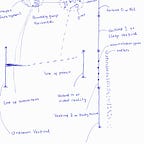panpsychism: why haven’t the standard model of particle physics explained the brain and mental health?
How were large language models able to interact with data that made them match many of the things that humans do digitally?
An answer is that a fundamental unit of data storage is bit. This is different from the elementary particles in the standard model of physics. All matter is composed of atoms — composed of subatomic particles.
Outside of organisms, the only things that have been able to display any semblance to a mind are LLMs. Panpsychism says mind-like is fundamental across the universe. This means that everything has an element of mind. However, no non-living thing has ever shown, even diminutively [aside generative AI] that this might be the case.
The human brain has atoms and subatomic particles. However, the level, conceptually, at which experiences arise exceed those, refuting the orchestrated objective reduction (Orch OR) theory of quantum consciousness.
Neuroscience has settled on neurons as responsible for brain functions. However, there has been no way to model neurons, close to 19 billion of them [aside from those in the cerebellum], to determine how experiences arise, how information is organized, what causes mental disorders or what indicates or sustains a good mental health.
This means that a level, just lower than neurons, could be where the answer is, to model for mental health. It is postulated that the interaction of electrical and chemical signals, in sets, or a brief strike-fuse [of signals] gives rise to experiences or organizes information. Also, in sets, electrical and chemical signals have features, qualifying their interactions.
Simply, the mind is the collection of electrical and chemical signals of nerve cells with their features and interactions, making them the standard of mind. This means that functions like memory, emotion, feeling and regulation are obtained by interactions, but what qualifiers them or grades them, like attention, awareness, subjectivity and intent, are qualifiers obtained within the set.
So, the mind is not just about a function, it is also about qualification. Organisms without a brain, but with neurons, work similarly. Those without neurons but cells, including those that are unicellular, have been shown by studies to have bioelectricity. It is proposed that this bioelectricity helps to qualify their functions, intra or inter-cellular.
For computers memory with bits as units, LLMs extract [and make] features [as numbers] interact. LLMs also quantize bits. AI is possible because of bits, a different type of fundamental unit, where LLMs apply weights and pattern match the storage states of digital memory.
Walls have atoms. They neither have bioelectricity nor bits. There is nothing so far, that can act on the atoms [or molecules] of walls, doors, tables, windows, to show some mind-like quality. Yes, LLMs have no feelings and emotions, but they have [access to] digital memory.
Books too have memory as texts and images, but the molecules of books can do nothing with them.
There are only two things that have shown their ability to bear a mind: cells and bits. Ions and molecules are able to mechanize a mind, as in the electrical and chemical impulses of nerve cells. However, they do, with cells as the host. Molecules are not subatomic. Ions too are not subatomic. Ions have an electric charge but are not subatomic. Invalidating completely that consciousness may arise from subatomic particles.
Ions, atoms, particles and molecules do not bear a mind anywhere else, outside of cells, regardless of external conditions. They function, but they do not have a memory that gets qualified.
Bits operationalize digital memory, but LLMs act on those, to result in what looks like analysis or correlations that sometimes match those from the human mind.
The question that should be asked is why do ions and molecules, underscored by cells, bear a mind, but not anywhere else? And why do they lead to consciousness? A postulate is that within the cell environment, molecules organize to take up roles for information. This is different from states of matter where they are arranged and can change. In the cell environment, they not only can bear information, they can also qualify it, answering for consciousness. This applies as well to ions within the cell environment.
Panpsychism is baseless and without merit since no other non-organism aside from AI has shown mind likeness or the possibility to have a mind function — of memory, with qualifications.
Functions of objects like vehicles, fans, wool, timber and so forth are neither mind nor like memory, since they cannot act on themselves, without external input, unlike LLMs, to digital memory.
